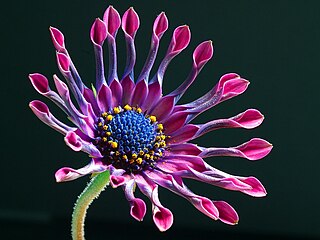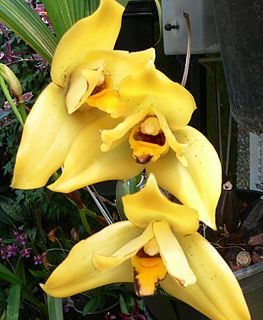
A cultivar is a type of plant that people have bred for desired traits, which are reproduced in each new generation by a method such as grafting, tissue culture, or carefully controlled seed production. Most cultivars arise from purposeful human manipulation, but some originate from wild plants that have distinctive characteristics. Cultivar names are chosen according to rules of the International Code of Nomenclature for Cultivated Plants (ICNCP), and not all cultivated plants qualify as cultivars. Horticulturists generally believe the word cultivar was coined as a term meaning "cultivated variety".
In botanical nomenclature, variety is a taxonomic rank below that of species and subspecies, but above that of form. As such, it gets a three-part infraspecific name. It is sometimes recommended that the subspecies rank should be used to recognize geographic distinctiveness, whereas the variety rank is appropriate if the taxon is seen throughout the geographic range of the species.
In botany and plant taxonomy, a series is a subdivision of a genus, a taxonomic rank below that of section but above that of species.

A botanical name is a formal scientific name conforming to the International Code of Nomenclature for algae, fungi, and plants (ICN) and, if it concerns a plant cultigen, the additional cultivar or Group epithets must conform to the International Code of Nomenclature for Cultivated Plants (ICNCP). The code of nomenclature covers "all organisms traditionally treated as algae, fungi, or plants, whether fossil or non-fossil, including blue-green algae (Cyanobacteria), chytrids, oomycetes, slime moulds and photosynthetic protists with their taxonomically related non-photosynthetic groups ."
In taxonomy, a nomen nudum is a designation which looks exactly like a scientific name of an organism, and may have originally been intended to be a scientific name, but fails to be one because it has not been published with an adequate description. This makes it a "bare" or "naked" name, one which cannot be accepted as it stands. A largely equivalent but much less frequently used term is nomen tantum.
In botany, an infraspecific name is the scientific name for any taxon below the rank of species, i.e. an infraspecific taxon or infraspecies. The scientific names of botanical taxa are regulated by the International Code of Nomenclature for algae, fungi, and plants (ICN). This specifies a 'three part name' for infraspecific taxa, plus a 'connecting term' to indicate the rank of the name. An example of such a name is Astrophytum myriostigma subvar. glabrum, the name of a subvariety of the species Astrophytum myriostigma.
The International Code of Nomenclature for Cultivated Plants (ICNCP), is a guide to the rules and regulations for naming cultigens, plants whose origin or selection is primarily due to intentional human activity. It is also known as Cultivated Plant Code. Cultigens under the purview of the ICNCP include cultivars, Groups, and grexes. All organisms traditionally considered to be plants are included. Taxa that receive a name under the ICNCP will also be included within taxa named under the International Code of Nomenclature for algae, fungi, and plants, for example, a cultivar is a member of a species.
A Group is a formal category in the International Code of Nomenclature for Cultivated Plants (ICNCP) used for cultivated plants (cultivars) that share a defined characteristic. It is represented in a botanical name by the symbol Group or Gp. "Group" or "Gp" is always written with a capital G in a botanical name, or epithet. The Group is not italicized in a plant's name. The ICNCP introduced the term and symbol "Group" in 2004, as a replacement for the lengthy and hyphenated "cultivar-group", which had previously been the category's name since 1969. For the old name "cultivar-group", the non-standard abbreviation cv. group or cv. Group is also sometimes encountered. There is a slight difference in meaning, since a cultivar-group was defined to comprise cultivars, whereas a Group may include individual plants.

The American Rose Center is a rose garden in Shreveport, Louisiana owned and operated by The American Rose Society. There are over 20,000 rose bushes of 100 varieties in 65 separate rose gardens on 118 acres of pine forests and woodlands.
In botanical nomenclature, a hybrid may be given a hybrid name, which is a special kind of botanical name, but there is no requirement that a hybrid name should be created for plants that are believed to be of hybrid origin. The International Code of Nomenclature for algae, fungi, and plants (ICNafp) provides the following options in dealing with a hybrid:
A cultigen or cultivated plant is a plant that has been deliberately altered or selected by humans; it is the result of artificial selection. These plants, for the most part, have commercial value in horticulture, agriculture or forestry. Because cultigens are defined by their mode of origin and not by where they are growing, plants meeting this definition remain cultigens whether they are naturalised in the wild, deliberately planted in the wild, or growing in cultivation.
The Australian Cultivar Registration Authority (ACRA) is the International Cultivar Registration Authority (ICRA) for Australian plant genera, excluding those genera or groups for which other ICRAs have been appointed.
The American Begonia Society is a horticultural society devoted to the promotion, cultivation, and study of begonias. The organization was founded in 1932, and has a worldwide membership. It is the International Cultivar Registration Authority for begonias.

Priority is a fundamental principle of modern botanical nomenclature and zoological nomenclature. Essentially, it is the principle of recognising the first valid application of a name to a plant or animal. There are two aspects to this:
- The first formal scientific name given to a plant or animal taxon shall be the name that is to be used, called the valid name in zoology and correct name in botany.
- Once a name has been used, no subsequent publication of that name for another taxon shall be valid (zoology) or validly published (botany).
Horticultural botany is the study of the botany of current and potential cultivated plants, with emphasis on the ornamental plants of horticulture, by a horticultural botanist or plantsman—plantsperson."

Cultivated plant taxonomy is the study of the theory and practice of the science that identifies, describes, classifies, and names cultigens—those plants whose origin or selection is primarily due to intentional human activity. Cultivated plant taxonomists do, however, work with all kinds of plants in cultivation.

The term grex, derived from the Latin noun grex, gregis, meaning 'flock', has been expanded in botanical nomenclature to describe hybrids of orchids, based solely on their parentage. Grex names are one of the three categories of plant names governed by the International Code of Nomenclature for Cultivated Plants; within a grex the cultivar group category can be used to refer to plants by their shared characteristics, and individual orchid plants can be selected and named as cultivars.
The International Society for Horticultural Science (ISHS) is the world's leading independent organization of horticultural scientists. Its aim is "to promote and encourage research and education in all branches of horticultural science and to facilitate cooperation and knowledge transfer on a global scale through its symposia and congresses, publications and scientific structure." Membership is open to all interested researchers, educators, students and horticultural industry professionals.
Freek Vrugtman was a Canadian botanist and horticulturist. Vrugtman was Curator at both University of British Columbia Botanical Garden in Vancouver, British Columbia, and Royal Botanical Gardens (RBG) in Burlington, Ontario, Canada. For 45 years he served as the International Registrar for Hybrid Cultivars of Lilacs in the Genus Syringa.





